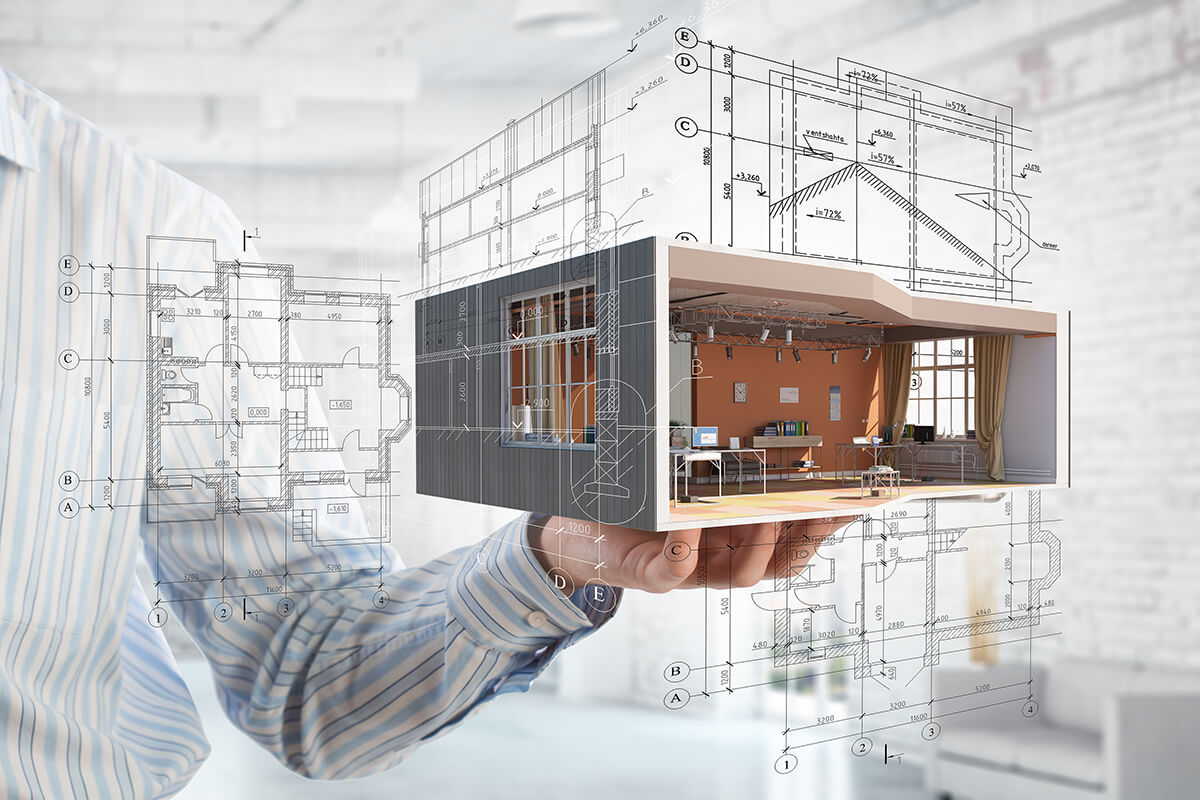Architect-Approved Home Remodeling Ideas
Architect-Approved Home Remodeling Ideas
Blog Article
Recognizing the Diverse Job Paths Available for Aspiring Architect
As an ambitious Architect, you have a world of job paths waiting for you. Each course uses special obstacles and chances to use your creativity and technical expertise. Whether you're drawn to typical design or the nuances of sustainable design, there's a specific niche that aligns with your passions. Recognizing these varied options can form your expert journey, however which instructions will you pick to check out first?
Standard Architecture: Designing Frameworks and structures
Standard style concentrates on developing structures and frameworks that mix functionality with visual charm. As you explore this field, you'll appreciate the intricate balance between form and objective. You'll find out to draw motivation from historic styles, integrating aspects like balance, products, and workmanship. Your styles can show social heritage, showcasing local traditions while meeting contemporary demands.
You'll develop skills in preparing, model-making, and website evaluation, permitting you to picture and interact your concepts efficiently. Involving with clients, you'll require to understand their vision and equate it into practical designs.
Additionally, building codes and sustainability practices are vital in your work, guaranteeing your structures are risk-free and ecologically pleasant. As you expand in your career, you'll find chances in household, industrial, and even repair projects, each offering unique challenges. Embracing traditional design leads the way for a satisfying job that pays tribute to the past while shaping the future.
Urban Preparation: Forming Communities and Public Spaces
As an ambitious Architect, you can play a vital duty as a metropolitan coordinator, transforming just how areas operate and interact. By employing neighborhood interaction techniques, you'll ensure that homeowners have a voice fit their environment. Plus, integrating sustainable style concepts will assist develop areas that not only satisfy today's requirements however additionally safeguard the future.
Duty of Urban Planners
While many could assume of designers as the sole enthusiasts behind structures, metropolitan coordinators play an essential duty in forming the wider landscape of neighborhoods and public rooms. They evaluate land usage, zoning legislations, and neighborhood requires to create lasting atmospheres that improve lifestyle. By collaborating with different stakeholders, you'll aid develop parks, transport systems, and suburbs that promote social communication and access. Urban organizers additionally focus on ecological factors to consider, guaranteeing that advancements integrate eco-friendly areas and support biodiversity. Your know-how in spatial design and neighborhood dynamics permits you to envision future growth while preserving cultural heritage. In this essential role, you'll directly influence exactly how individuals experience their surroundings, making every job a chance for favorable adjustment.
Neighborhood Involvement Techniques
Reliable neighborhood involvement techniques are important for urban organizers to assure that the voices of homeowners are listened to and valued in the preparation procedure. To foster meaningful discussion, you ought to prioritize open forums and workshops where area participants can express their ideas and concerns. By proactively paying attention and integrating feedback, you'll create areas that reflect the community's requirements, ultimately leading to more sustainable and successful metropolitan environments.
Lasting Style Principles
When designing urban rooms, incorporating lasting layout principles is crucial for producing environments that thrive both ecologically and socially. Consider integrating environment-friendly areas, like gardens and parks, to enhance biodiversity and boost air quality.
Creating with water preservation in mind is additionally vital-- consider rainfall gardens and permeable surface areas to take care of stormwater. Involving neighborhood participants during the preparation process warranties that the areas you develop satisfy their demands and motivate social interaction. By embracing these principles, you'll add to lively, lasting urban landscapes that benefit everyone.

Landscape Style: Creating Lasting Outside Environments
As you check out landscape style, you'll uncover essential style principles that develop functional and beautiful exterior spaces. Lasting methods play an important function in ensuring these atmospheres grow while reducing ecological impact. And also, you'll locate a range of career chances that enable you to make an actual distinction in how individuals communicate with nature.
Design Concepts in Landscape
Recognizing layout principles in landscape style is crucial for developing lasting exterior settings that integrate with nature. You'll require to ponder aspects like balance, percentage, and range to assure your layouts feel cohesive and welcoming. In addition, pay focus to seasonal adjustments, developing with products that match the surroundings year-round.
Sustainable Practices Summary
Sustainable practices in landscape design not only focus on appearances however likewise focus on ecological wellness and source preservation. By incorporating indigenous plants, you improve biodiversity and decrease the need for chemical plant foods and pesticides. Executing effective watering systems aids preserve water and decreases overflow, securing nearby environments. You can develop spaces that promote dirt wellness, such as exercising and making use of organic products permaculture principles. In addition, integrating green framework, like rain yards and porous sidewalks, aids in stormwater monitoring and decreases city warm. You add to a healthier earth and offer spaces that cultivate community link when you create outside settings with sustainability in mind. Eventually, these practices assure your styles profit both people and the atmosphere for years to find.
Profession Opportunities Expedition
With a strong foundation in lasting practices, landscape style uses a range of career courses that allow you to make a significant effect on the environment. You can function as a landscape developer, developing visually pleasing and practical outside areas, or focus on environmental remediation, aiding to restore broken ecological communities. Urban organizers typically team up with landscape architects to develop green areas in city settings, improving city livability. If you're enthusiastic about education and learning, take into consideration ending up being a landscape design instructor, inspiring future generations. In addition, you could function with nonprofits focused on environmental sustainability or take part in study to innovate new techniques. Each course not only forms gorgeous environments yet likewise cultivates a much healthier planet for future generations.
Sustainable Layout: Concentrating On Eco-Friendly Practices
As you discover your job in style, accepting environmentally friendly techniques can set you apart in an affordable area. Sustainable style concentrates on developing structures that reduce helpful site ecological impact while enhancing occupant wellness. By integrating sustainable products, energy-efficient systems, and sustainable building methods, you'll add to a greener future.
Start by obtaining expertise of environment-friendly accreditations like LEED or BREEAM, which can boost your credentials. Consider just how natural light, ventilation, and thermal effectiveness can maximize design. Collaborate with designers and ecological experts to innovate remedies that minimize waste and save sources.
Do not neglect the importance of neighborhood involvement-- engaging local stakeholders can inspire styles that balance with the environment. As clients progressively focus on sustainability, your know-how in environmentally friendly methods will not just draw in jobs but additionally accomplish your enthusiasm Our site for responsible architecture. Embrace this vital element of the occupation, and view your career flourish.
Historical Conservation: Safeguarding and Restoring Cultural Heritage
While you start on your architectural journey, think about the important role of historical preservation in maintaining our cultural heritage. This area focuses on the protection and repair of considerable structures, sites, and frameworks that inform the stories of our past. By taking part in historic preservation, you'll aid protect the building heritage that forms community identification.
As a historic conservation Architect, you'll assess historic relevance and assess the condition of frameworks. You'll function closely with historians and preservationists to ensure authentic reconstruction strategies are utilized. This career course enables you to blend imagination with study, allowing you to create solutions that appreciate initial materials and workmanship.
Your job not only adds to sustainability by reusing existing buildings yet also promotes a feeling of satisfaction within neighborhoods. Accepting this course will help you end up being a guardian of history, protecting the tales and looks that enrich our lives.
Interior Architecture: Enhancing Indoor Spaces
Historical conservation and indoor style both share a commitment to boosting the built atmosphere, however they concentrate on various aspects. While historical conservation emphasizes keeping a framework's cultural and historical value, interior design nos in on optimizing indoor rooms for capability and aesthetics.
As an ambitious Architect, you'll find that interior architecture enables you to mix creative thinking with technological abilities. You'll make areas that not just look good but likewise advertise comfort and performance. This area entails comprehending just how light, color, and products communicate within a room, affecting state of mind and usability.
You'll function on various tasks, from property homes to commercial workplaces, ensuring that each atmosphere meets the requirements of its occupants. By prioritizing individual experience, you can change insides right into practical and inspiring rooms, making a substantial effect on just how people engage with their surroundings. Embrace the opportunity to boost indoor atmospheres and form the means individuals function and live.
Industrial Layout: Combining Performance With Looks
Commercial design plays an essential duty in producing products that effortlessly mix looks with capability, making sure that what you make use of day-to-day is not only visually attractive yet additionally useful. As an ambitious Architect, you might involve on your own in this field, concentrating on creating everything from furnishings to Visit Website consumer electronic devices. Your job involves recognizing customer requirements, products, and producing procedures, enabling you to develop cutting-edge services that boost daily experiences.
In commercial layout, you'll frequently team up with engineers, marketing experts, and makers, making sure that your designs are not just attractive yet likewise practical. You'll discover to balance kind and feature, prioritizing functionality without giving up style. By honing your abilities in laying out, 3D modeling, and prototyping, you'll be fully equipped to bring your ideas to life. This career course uses a dynamic setting where imagination satisfies practicality, making it a fulfilling choice for architects interested in shaping the products of tomorrow.
Often Asked Concerns
What Educational Qualifications Do I Required to End Up Being an Architect?
To come to be a designer, you'll need a specialist degree in architecture, commonly a Bachelor's or Master's. Furthermore, you'll have to finish an internship and pass the Architect Registration Examination to exercise legally.
Exist Certification Needs for Different Architectural Occupation Paths?
Yes, there're accreditation requirements for different architectural courses. Architect. You'll need to pass tests, complete teaching fellowships, and in some cases seek specialized training, depending upon your picked focus, like landscape style, urban style, or historical preservation
What Software Program Skills Are Crucial for Designers Today?

Exactly How Can I Gain Practical Experience While Studying Style?
You can acquire sensible experience by interning at building firms, taking part in design competitors, volunteering for area jobs, or teaming up with classmates on real-world assignments. These chances enhance your skills and construct important connections in the market.
What Task Opportunities Exist Outdoors Conventional Style Firms?
You can explore different work chances outside typical architecture firms, like city planning, interior decoration, landscape architecture, building monitoring, realty advancement, and even roles in sustainability consulting. Each offers special obstacles and rewards.
Whether you're drawn to standard style or the nuances of sustainable style, there's a niche that straightens with your interests.When creating city rooms, incorporating sustainable style concepts is crucial for creating atmospheres that prosper both environmentally and socially.As you discover landscape style, you'll discover necessary style principles that produce functional and gorgeous outside areas.Comprehending style principles in landscape design is necessary for producing lasting outside atmospheres that integrate with nature.In commercial layout, you'll usually team up with marketers, designers, and suppliers, making sure that your designs are not just attractive yet likewise possible.
Report this page